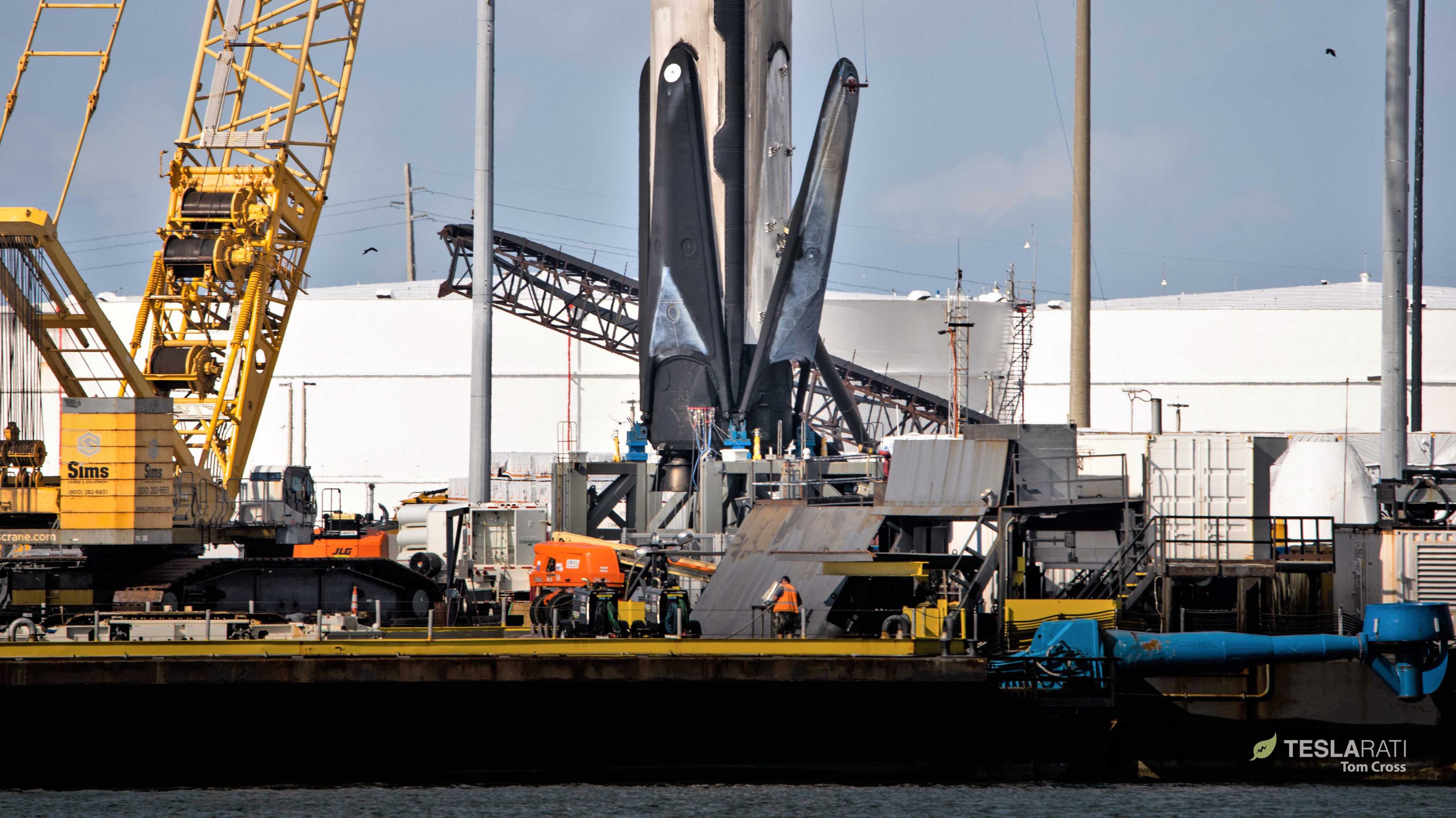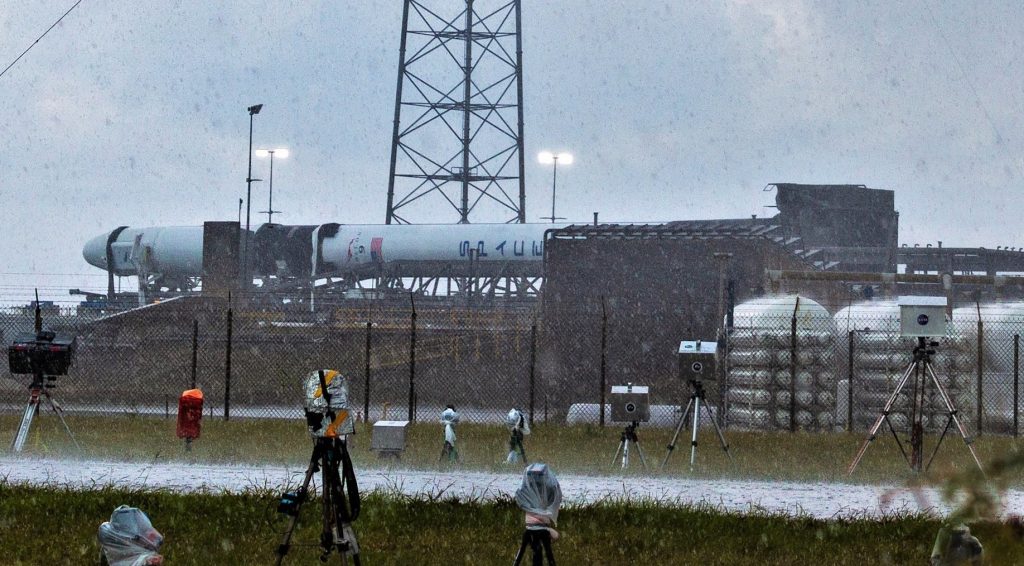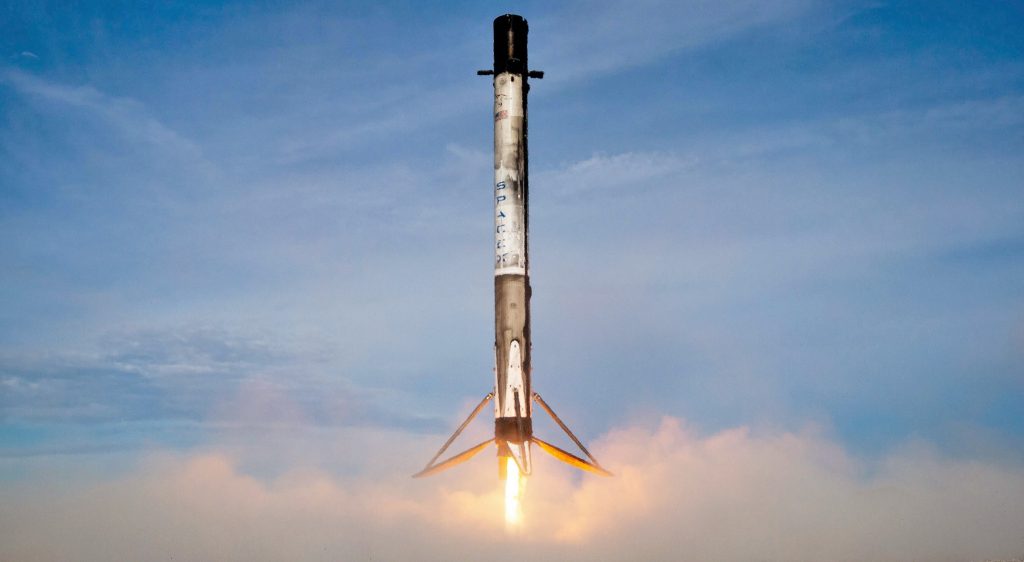

News
SpaceX's next rocket launch on track to break a 20-month-old booster reusability record
Scheduled as early as next week, SpaceX’s next rocket launch could see the company break a 20-month-old record that is closely intertwined with the reusability of its Falcon 9 and Falcon Heavy boosters.
Unsurprisingly, that record – if broken – will tag along on one of up to two dozen Starlink satellite launches SpaceX has planned for 2020. The fourth launch of upgraded Starlink v1.0 satellites and fifth dedicated launch overall, SpaceX’s next Starlink mission – deemed Starlink V1 L4 – is currently set to lift off no earlier than (NET) 10:46 am EST (15:46 UTC) on February 15th. As usual, the mission’s Falcon 9 booster will attempt to land aboard drone ship Of Course I Still Love You (OCISLY), while SpaceX recovery ships Ms. Tree and Ms. Chief may attempt to catch both Falcon payload fairing halves for the third time ever.
According to Next Spaceflight, SpaceX has assigned thrice-flown Falcon 9 booster B1056 to the Starlink launch, potentially making it the fourth SpaceX rocket to complete four separate launches. However, while SpaceX’s fourth fourth-flight milestone is significant, B1056 is – barring delays – also set to break a record that could be even more important for rocket reusability.

SpaceX’s 10th finished Falcon 9 Block 5 booster, B1056 completed a flawless launch and landing debut on May 4th, 2019, sending Cargo Dragon on its way to orbit for CRS-17, the spacecraft’s 17th International Space Station (ISS) resupply mission. Instead of a more normal return-to-launch-site (RTLS) recovery at SpaceX’s Cape Canaveral-based Landing Zone, SpaceX opted to land the booster on drone ship OCISLY.

It’s believed that SpaceX and NASA made that decision out of an abundance of caution after an attempted LZ recovery following the Falcon 9 B1050’s CRS-16 Cargo Dragon launch saw the booster lose control and crash-land in the Atlantic Ocean less than a mile off the coast.
Regardless, SpaceX’s subsequent CRS-17 Cargo Dragon launch went exactly as planned and Falcon 9 B1056 landed smoothly aboard drone ship OCISLY. Less than two days after returning to Port Canaveral, B1056 even became the first SpaceX booster to have its landing legs retracted – a small but significant step along the path to true airplane-like reusability. 82 days later, B1056 successfully completed its second launch, sending another Cargo Dragon its CRS-18 resupply mission before landing at LZ-1. The booster completed its third mission a bit less than five months later, placing the 6800 kg (15,000 lb) Kacific-1 communications satellite into geostationary transfer orbit (GTO) on December 16th, 2019.


Now, SpaceX wants to launch B1056 for the fourth time as early as February 15th. Close observers will note that that would imply just 61 days between B1056’s Kacific-1 and Starlink V1 L4 launches, a feat that would make it SpaceX’s fastest ‘booster turnaround’ ever. Currently, that record stands at 71 days and was actually achieved just a month after SpaceX debuted Falcon 9’s reusability-focused Block 5 upgrade. However, that record turnaround was actually achieved by the B1045, SpaceX’s last Falcon 9 Block 4 booster.
Surprisingly, the closest SpaceX’s upgraded Block 5 rockets have gotten to beating B1045’s 71-day record was when the company turned around Falcon Heavy side boosters B1052 and B1053 in just 74 days before completing the giant rocket’s third orbital launch since February 2018. Now, barring calamities worthy of a ten-day delay, it looks likely that Falcon 9 booster B1056 will beat out the current record-holder by up to ten days (~15%).
According to a SpaceX engineer’s January 2020 presentation, SpaceX is currently capable of landing, refurbishing, and relaunching Falcon 9 and Falcon Heavy boosters in about a month (~30 days). With Falcon 9 B1056’s Starlink V1 L4 launch, SpaceX will hopefully be taking its biggest step in 20 months towards the goal of reusing Falcon boosters in a matter of days.
Check out Teslarati’s Marketplace! We offer Tesla accessories, including for the Tesla Cybertruck and Tesla Model 3.
News
These Tesla, X, and xAI engineers were just poached by OpenAI
The news is the latest in an ongoing feud between Elon Musk and the Sam Altman-run firm OpenAI.

OpenAI, the xAI competitor for which Elon Musk previously served as a boardmember and helped to co-found, has reportedly poached high-level engineers from Tesla, along with others from xAI, X, and still others.
On Tuesday, Wired reported that OpenAI hired four high-level engineers from Tesla, xAI, and X, as seen in an internal Slack message sent by co-founder Greg Brockman. The engineers include Tesla Vice President of Software Engineering David Lau, X and xAI’s head of infrastructure engineering Uday Ruddarraju, and fellow xAI infrastructure engineer Mike Dalton. The hiring spree also included Angela Fan, an AI researcher from Meta.
“We’re excited to welcome these new members to our scaling team,” said Hannah Wong, an OpenAI spokesperson. “Our approach is to continue building and bringing together world-class infrastructure, research, and product teams to accelerate our mission and deliver the benefits of AI to hundreds of millions of people.”
Lau has been in his position as Tesla’s VP of Software Engineering since 2017, after previously working for the company’s firmware, platforms, and system integration divisions.
“It has become incredibly clear to me that accelerating progress towards safe, well-aligned artificial general intelligence is the most rewarding mission I could imagine for the next chapter of my career,” Lau said in a statement to Wired.
🚨Optimistic projections point to xAI possibly attaining profitability by 2027, according to Bloomberg's sources.
If accurate, this would be quite a feat for xAI. OpenAI, its biggest rival, is still looking at 2029 as the year it could become cash flow positive.💰 https://t.co/pE5Z9daez8
— TESLARATI (@Teslarati) June 18, 2025
READ MORE ON OPENAI: Elon Musk’s OpenAI lawsuit clears hurdle as trial looms
At xAI, Ruddarraju and Dalton both played a large role in developing the Colossus supercomputer, which is comprised of over 200,000 GPUs. One of the major ongoing projects at OpenAI is the company’s Stargate program,
“Infrastructure is where research meets reality, and OpenAI has already demonstrated this successfully,” Ruddarraju told Wired in another statement. “Stargate, in particular, is an infrastructure moonshot that perfectly matches the ambitious, systems-level challenges I love taking on.”
Elon Musk is currently in the process of suing OpenAI for shifting toward a for-profit model, as well as for accepting an investment of billions of dollars from Microsoft. OpenAI retaliated with a counterlawsuit, in which it alleges that Musk is interfering with the company’s business and engaging in unfair competition practices.
Elon Musk confirms Grok 4 launch on July 9 with livestream event
News
SpaceX share sale expected to back $400 billion valuation
The new SpaceX valuation would represent yet another record-high as far as privately-held companies in the U.S. go.

A new report this week suggests that Elon Musk-led rocket company SpaceX is considering an insider share sale that would value the company at $400 billion.
SpaceX is set to launch a primary fundraising round and sell a small number of new shares to investors, according to the report from Bloomberg, which cited people familiar with the matter who asked to remain anonymous due to the information not yet being public. Additionally, the company would sell shares from employees and early investors in a follow-up round, while the primary round would determine the price for the secondary round.
The valuation would represent the largest in history from a privately-owned company in the U.S., surpassing SpaceX’s previous record of $350 billion after a share buyback in December. Rivaling company valuations include ByteDance, the parent company of TikTok, as well as OpenAI.
Bloomberg went on to say that a SpaceX representative didn’t respond to a request for comment at the time of publishing. The publication also notes that the details of such a deal could still change, especially depending on interest from the insider sellers and share buyers.
Axiom’s Ax-4 astronauts arriving to the ISS! https://t.co/WQtTODaYfj
— TESLARATI (@Teslarati) June 26, 2025
READ MORE ON SPACEX: SpaceX to decommission Dragon spacecraft in response to Pres. Trump war of words with Elon Musk
SpaceX’s valuation comes from a few different key factors, especially including the continued expansion of the company’s Starlink satellite internet company. According to the report, Starlink accounts for over half of the company’s yearly revenue. Meanwhile, the company produced its 10 millionth Starlink kit last month.
The company also continues to develop its Starship reusable rocket program, despite the company experiencing an explosion of the rocket on the test stand in Texas last month.
The company has also launched payloads for a number of companies and government contracts. In recent weeks, SpaceX launched Axiom’s Ax-4 mission, sending four astronauts to the International Space Station (ISS) for a 14-day stay to work on around 60 scientific experiments. The mission was launched using the SpaceX Falcon 9 rocket and a new Crew Dragon capsule, while the research is expected to span a range of fields including biology, material and physical sciences, and demonstrations of specialized technology.
News
Tesla Giga Texas continues to pile up with Cybercab castings
Tesla sure is gathering a lot of Cybercab components around the Giga Texas complex.

Tesla may be extremely tight-lipped about the new affordable models that it was expected to start producing in the first half of the year, but the company sure is gathering a lot of Cybercab castings around the Giga Texas complex. This is, at least, as per recent images taken of the facility.
Cybercab castings galore
As per longtime drone operator Joe Tegtmeyer, who has been chronicling the developments around the Giga Texas complex for several years now, the electric vehicle maker seems to be gathering hundreds of Cybercab castings around the factory.
Based on observations from industry watchers, the drone operator appears to have captured images of about 180 front and 180 rear Cybercab castings in his recent photos.
Considering the number of castings that were spotted around Giga Texas, it would appear that Tesla may indeed be preparing for the vehicle’s start of trial production sometime later this year. Interestingly enough, large numbers of Cybercab castings have been spotted around the Giga Texas complex in the past few months.
Cybercab production
The Cybercab is expected to be Tesla’s first vehicle that will adopt the company’s “unboxed” process. As per Tesla’s previous update letters, volume production of the Cybercab should start in 2026. So far, prototypes of the Cybercab have been spotted testing around Giga Texas, and expectations are high that the vehicle’s initial trial production should start this year.
With the start of Tesla’s dedicated Robotaxi service around Austin, it might only be a matter of time before the Cybercab starts being tested on public roads as well. When this happens, it would be very difficult to deny the fact that Tesla really does have a safe, working autonomous driving system, and it has the perfect vehicle for it, too.
-

 Elon Musk1 week ago
Elon Musk1 week agoTesla investors will be shocked by Jim Cramer’s latest assessment
-

 News2 weeks ago
News2 weeks agoTesla Robotaxi’s biggest challenge seems to be this one thing
-

 Elon Musk1 day ago
Elon Musk1 day agoElon Musk confirms Grok 4 launch on July 9 with livestream event
-

 News2 weeks ago
News2 weeks agoWatch the first true Tesla Robotaxi intervention by safety monitor
-

 News5 days ago
News5 days agoTesla Model 3 ranks as the safest new car in Europe for 2025, per Euro NCAP tests
-

 Elon Musk2 weeks ago
Elon Musk2 weeks agoA Tesla just delivered itself to a customer autonomously, Elon Musk confirms
-

 Elon Musk2 weeks ago
Elon Musk2 weeks agoxAI welcomes Memphis pollution results, environmental groups push back
-

 Elon Musk2 weeks ago
Elon Musk2 weeks agoElon Musk confirms Tesla Optimus V3 already uses Grok voice AI

















